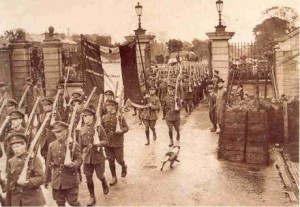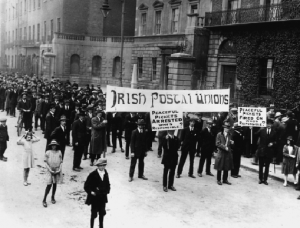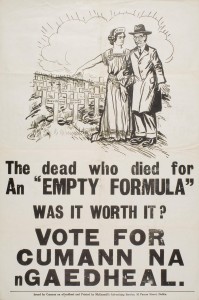Why was there a Civil War in Ireland?

By John Dorney
Why was there a Civil War in Ireland in 1922-23? Why did those who had been comrades in pursuit of Irish independence over the previous four years begin killing each other over the Anglo-Irish Treaty?
The short answer to this question is that irreconcilable differences over the Treaty divided them. But the recourse to arms was not inevitable, and the internecine bloodletting was deeply unpopular with the general public. Why then, did it happen?
One reason was certainly the shortcomings of the Treaty itself from the separatist perspective. The Oath of fidelity to the British monarch, the Free State’s membership of the British Empire, the ports retained by the Royal navy and (though this was not as clear as it became in hindsight) the partition of Ireland were difficult compromises to sell.
In the Dáil, it was just possible to pass the deal, after angry debates, on January 7 1922, though the former President Eamon de Valera and his followers walked out in protest. This political split would have caused acrimony, but probably not civil war, had it not been accompanied by a parallel split among the armed republican organisations.
The Treaty caused a political split but it resulted in armed conflict due to the unhealed rift in the IRA
A generation of young activists had struggled and been to prison, killed and watched their friends die, for the Republic declared in January 1919. For them, compromise was for weak-willed previous generations, for the followers of John Redmond and the Irish Parliamentary Party, whom Sinn Fein had thrown aside in the election of 1918. Compromise meant defeat. Many also believed that Britain had no real wish to fight and that all that was needed to achieve total independence was a strong will.
Such attitudes were most pronounced in the fighting organisations; the IRA, Cumman na mBan and the Fianna, in all which there was a majority against the Treaty. From February to March 1922, these paramilitary groups voted one after the other to reject the Treaty, in defiance of the Dáil and also of IRA General Headquarters.
IRA Split

The IRA Convention, on March 26 1922, in Dublin’s Mansion House, saw delegates vote, not only to reject the Treaty but to assert that, since the Dáil had broken its oath to the Irish Republic, the Republican Army would no longer answer to it, but to its own elected Executive.
Contrary to what Michael Collins, head of the Provisional Government and IRA Director of Intelligence, had hoped, it proved impossible to persuade the majority of militants that the Treaty was, as he argued, merely a tactical device, a ‘stepping stone’ to full independence. Neither his undoubted personal charisma and following within the IRA, nor his presidency over the clandestine Irish Republican Brotherhood, or even the offer of paid posts in the new National Army were enough to shift the majority of anti-Treatyites.
Thus, by the spring of 1922 there were two rival Irish armies in the territory of the nascent Free State; the pro-Treaty ‘National Army’ (still at this early stage sometimes called the ‘official IRA’) and the anti- Treaty IRA, known to its supporters as ‘Executive forces’ and to its detractors as ‘irregulars’ or ‘mutineers’.
This splintering contributed also to a rapidly deteriorating law and order situation, in which armed robbery became commonplace. As pro-Treaty Attorney General Cahir Davitt later put it, ‘to put matters bluntly, every criminally disposed person had a gun, either from the Government or from Mr de Valera’.
First clashes

The first clashes between the two factions occurred in March and April 1922 over which side would occupy barracks being vacated by the departing British Army and the disbanded Royal Irish Constabulary. A dangerous stand-off occurred in Limerick city in March between several hundred armed men on either side that was only defused when it was agreed to divide up the city’s barracks between them.
In Dublin shots were exchanged when pro-treaty forces occupied Wellington and Portobello Barracks on the city’s southside in early April. On April 14, the anti-Treatyites seized the Four Courts in central Dublin, the centre of the Irish legal system, as a base for their forces and the IRA Executive.
The security of the Provisional government in its capital began to look doubtful. Vinny Byrne, for instance, a stalwart of Michael Collins’ IRA ‘Squad’ and now a pro-Treaty officer, drove down to the Bank of Ireland on College Green when he heard rumours that the garrison there was changing sides. He and other officers ‘threatened to shoot any man who left his post’ and proceeded to drive around every other post in the city and addressed the men there to try to secure their loyalty. Shots were exchanged in subsequent nights between pro and anti-Treaty IRA at the Bank of Ireland, Beggars Bush and Wellington barracks.
There were serious armed clashes between the two sides in April and May 1922 before a temporary ‘pact’ was brokered.
There was a serious gun battle in Mullingar in late April which saw four men killed, an ambush killing four pro-Treaty soldiers in Donegal and two days of fighting in Kilkenny city when anti-Treatyites seized the castle there, in early May. There were also a host of other shootings and hundreds of post office and bank robberies.
This period also saw a serious of shootings of civilians in West Cork around Dunmanway, apparently by local anti-Treaty IRA units in which 13 local Protestant men were killed, it is though in reprisal for the fatal shooting of an IRA officer by a loyalist.
In the Provisional Government cabinet, Arthur Griffith was apparently keen from an early stage that force would be used to uphold the government’s authority. Michael Collins at this point overruled him.
It appeared, nevertheless, that Civil War was already at hand between the rival factions by that time. Yet compromise was still possible.
Stepping back from brink

For one thing, the violence represented jockeying for position between two rival factions, not mass polarisation. County councils across the country passed resolutions pleading for peace. On April 23 1922, the Irish Trade Union Congress called a general one-day strike ‘against militarism’, and the prospect of Civil War.
The strike, according to the press, ‘brought about a complete paralysis of all the nerves of industrial, commercial and social life’ and was widely applauded in the press and pulpit. There was no public appetite for war over the Treaty.
Nor was there an ideological gulf between the two sides. After the Civil War, the anti-Treatyites would depict the Provisional Government as ‘a gang of traitors’ and their army as composed of mercenary former British soldiers. The pro-treatyites would imagine that the ‘irregulars’ were either youthful ‘trucileers’ who had been neither brave enough nor old enough to fight the British, or as mere criminals. But in the early months of 1922, both sides were composed, in the main, of sincere Irish republicans.
the anti-Treaty side planned obstruction rather than overthrow of the Provisional Government and the prospect of Civil War was extremely unpopular with the public.
Thirdly, the anti-Treatyites were divided among themselves. Eamon de Valera, who had formed his own political party Cumann na Poblachta, advocated, not holding fast to the Irish Republic, but a revision of the Treaty – ‘Document No. 2’ – whereby Ireland would have ‘external association’ with the British Empire. This stance put him at odds with the hardliners of the anti-Treaty IRA.
De Valera’s verbal support for the IRA, his acquiescence in the occupation of Four Courts and his use of bloodthirsty rhetoric in his speeches in the spring of 1922, caused many pro-Treatyites to blame him personally for the Civil War. Most notoriously his assertion that ‘if the Treaty were accepted, the fight for freedom would still go on, and the Irish people, instead of fighting foreign soldiers… [and might] have to wade through the blood of the soldiers of the Irish Government, and perhaps through that of some members of the Irish Government to get their freedom’ associated him for many pro-Treatyites with uncompromising republican militarism.
The fact was, however, that far from leading the anti-treaty IRA, de Valera was not even allowed to attend meetings of its Executive until near the end of the Civil War. Even within the IRA Executive, there were strong differences of opinion and no clear plan. Those ensconced in the Four Courts, led by Rory O’Connor, wanted to attack the remaining British forces either in Dublin or in Northern Ireland with a view to provoking a draconian British response and collapsing the Treaty. The more moderate faction, headed by Liam Lynch, hoped for reconciliation with Michael Collins on the basis of a republican constitution for the new Free State.
And so, May 1922 saw short term compromise rather than descent into war. De Valera was talked into re-entering the Dáil and campaigning jointly in a re-united Sinn Fein for the Free State’s first general election in June. Liam Lynch entered into talks with Collins for ‘army -reunification’ and agreed to cooperate in clandestine guerrilla operations in Northern Ireland.
In some ways, this was a compromise that could not last. Collins quickly found that overt participation of pro-Treaty forces in the north could not be concealed from the British and abruptly cancelled their participation in a proposed ‘joint offensive’ there in late May.
The British insistence that the Free State constitution – published the day before the June election – must contain an oath of fidelity to the British monarch, exploded the prospect of political unity.
The election of June 16 saw pro-Treaty parties secure in the region of 80% of the popular vote, meaning that the Provisional Government could now speak with authority as acting for ‘the will of the people’.
Yet even now, Civil War was not inevitable. Eamon de Valera lamented the election result but stated that his followers would enter the Dáil, where he urged TDs not to ratify the proposed constitution.
Things fall apart

The standoff between government troops and the Four Courts and other anti-Treaty garrisons continued, but the latter resolved to ‘declare war on Britain’ but not to attack ‘Provisional government forces’.
In the end, it was the pressure of the British government that forced the outbreak of Civil War. In the wake of the assassination by IRA members in London (on whose authority is still not clear) of Field Marshal Sir Henry Wilson on June 22, an ultimatum was delivered by Prime Minister Lloyd George to Collins and the Provisional Government; disperse the Four Courts garrison, or our troops in Dublin – a 6,000 strong garrison supported by air power and artillery – will do it.
Their precise words were:
‘The ambiguous position of the Irish Republican Army can no longer be tolerated by the British government. Still less can Rory O’Connor be permitted to remain with his followers and his arsenal in the heart of Dublin in possession of the Courts of Justice… Continued toleration of this rebellious defiance of the principles of the Treaty [is] incompatible with its faithful execution’.
British pressure arising out of the untimely assassination of Field Marshal Henry Wilson by IRA men of undetermined allegiance was ultimately what sparked Civil War in Ireland.
The Provisional Government, knowing well the implications of such an action, prevaricated for several days, but took an initiative in arresting Leo Henderson, an IRA officer from the Four Courts who was seizing cars bound for Belfast, enforcing the anti-Treatyites’ ‘Belfast Boycott’. When, in retaliation, the anti-Treatyites seized pro-Treaty General J.J. O’Connell and held him in the Courts, it gave the Government a more acceptable reason to resort to force than an ultimatum from the British.
And so on June 28, with borrowed British artillery, pro-Treaty troops opened fire on the Four Courts. Civil War, long threatened, was now a reality.
Contrary to what the Provisional Government had hoped, it proved impossible to limit the conflagration either to the Four Courts, or even to Dublin. Within weeks it had spread throughout the country.
What kind of Civil War?

Allocating blame for the outbreak of Civil War between Irish nationalists in 1922 is still today a highly partisan issue in Ireland, even 100 years on.
It was certainly possible ,even after the IRA split, the disorder of early 1922 and the June election that all out conflict could have been avoided. As it was though, the Wilson assassination and the subsequent British ultimatum tipped the balance into confrontation.
For pro-Treatyites in 1922, the blame for this conflict fell squarely with the ‘Irregulars’ who in pursuit of abstract principles over concrete state building, were prepared to defy the lawful government the ‘will of the people’, making military action against them distasteful but inevitable.
For the anti-Treatyites, their stance in June 1922 had been purely defensive, defending the principle of the Irish Republic against British aggression, in light of which, they argued, ascertaining the true will of the Irish people was not possible. For them the outbreak of Civil War represented an unprovoked attack on their garrison in the Four Courts, on the orders of the British.
There was no real way to reconcile these two hostile narratives and so Civil War dragged on until the republican or anti-Treaty side, through defeat and exhaustion called it off in May 1923.
It is important to understand what kind of Civil War this was. It was not a case of mass polarisation of the population into rival factions or territorial blocks, in a manner akin to, for example the American or Spanish Civil Wars (1861-64 and 1936-39 respectively).
The public had not wanted Civil War and indeed had demonstrated repeatedly against its prospect.

But nor was it merely a squabble between military factions with no popular support. Rather, it represented an agonising ripping asunder of the popular movement that had struggled for Irish independence between 1919 and 1921.
The very closeness and intimacy of the conflict on the one hand probably encouraged ‘restraint’ in the use of violence, particularly against civilians but at the same time lent the conflict a bitter and unforgiving character when the combatants exchanged reprisals among those they had considered friends and comrades but now thought of as enemies and traitors.
This in part helps to explain its long and destructive legacy in Irish politics.
For the military course of the Civil War see – The Irish Civil War, a a short military history.